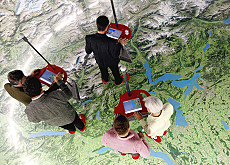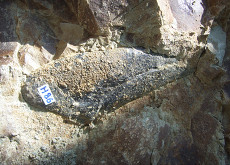New museum attraction is a walkover

Would you like to walk across Switzerland in a pair of slippers? Lucerne's Transport Museum gives you the opportunity.
Visitors can effortlessly follow some of the routes that the Swiss slogged over for centuries on foot or by mule.
One of the museum’s attractions is Swissarena, an aerial map of Switzerland on a scale of 1:20,000 – big enough to contain details down to the traffic on the roads, small enough to fit into a mere 200 square metres.
Visitors can look down from a balcony and see the whole thing. From Basel to Chiasso is 12 metres, from Geneva to Schaffhausen 15.
“It’s an aerial view of an entire country which you can walk on and yet make out individual houses,” says Blandina Werren, media officer for the Transport Museum, adding that it’s amazing to see how much green and how much water there is in Switzerland.
Swissarena uses the same photos as Google World – 7,800 of them. But it is quite different to see the country as a whole, rather than in small pieces on a screen.
It is the first time ever an entire country has been shown on such a scale – the advantage of having such a small territory.
If visitors put on a pair of museum moccasins they can walk over the map and get a new perspective on their town or village – at an equivalent height of 36 kilometres above the earth’s surface.
Interactive
The museum has recently enhanced the map with an interactive feature, which users are now testing out. This is the Rover: not a dog, but a touch-sensitive computer on wheels which acts as a guide to three historic routes.
The Rover uses a laser point on the ground to enable visitors to follow the routes, and its screen provides information about the places on the way.
The facility has been created in collaboration with ViaStoria, an organisation attached to Bern University which researches old transport routes across Switzerland.
Three so-called “cultural routes” are on offer: the ViaCook, ViaGottardo and ViaJacobi.
The ViaCook, named after 19th-century tourism pioneer Thomas Cook, starts in Geneva and goes in a loop around many of the classic Swiss tourist localities; the ViaGottardo links northern Switzerland with Italy; the ViaJacobi is part of the pilgrim route to Compostela in Spain and crosses Switzerland from northeast to southwest.
“With the Rover you can keep calling up information about history or about a particular location and also about items related to them which are exhibited in the Transport Museum,” Werren explained.
But she does not believe users will be overwhelmed. “Visitors can choose for themselves the things they like or find interesting,” she said.
And having learnt so much, perhaps some of them will exchange their moccasins for hiking boots and set off for real.
swissinfo, based on a German article by Christian Raaflaub in Lucerne
The Swissarena in Lucerne’s Transport Museum was opened in September 2002 and is now one of the most popular exhibits.
It consists of a coloured photo of Switzerland, comprising nearly 8,000 photos taken from a height of 4km.
Visitors can walk over the map, which is detailed enough to show individual houses.
In May 2007 the map was enhanced with the provision of computers on wheels which guide visitors down three so-called “cultural routes”, providing them with information.
The Transport Museum, which opened in 1959, is the most popular museum in Switzerland, with more than 455,000 visitors in 2006.
ViaStoria, the Centre of Transport History, researches and renovates historical transport routes and encourages their use.
Between 1984 and 2003 it drew up the Inventory of Historical Traffic Routes in Switzerland (IVS).
It is involved in the establishment of the Cultural Routes of Switzerland, based on historical paths and roads.
The 12 Cultural Routes are a tourism initiative, designed to encourage people to hike historic routes and enjoy regional specialities.

In compliance with the JTI standards
More: SWI swissinfo.ch certified by the Journalism Trust Initiative










You can find an overview of ongoing debates with our journalists here . Please join us!
If you want to start a conversation about a topic raised in this article or want to report factual errors, email us at english@swissinfo.ch.